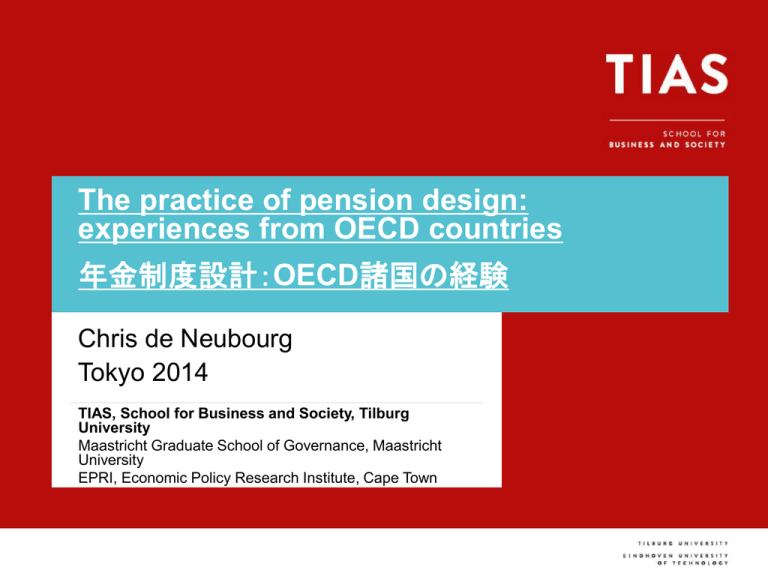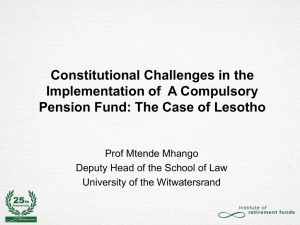2014 Tokyo lecture 2 3 and 4
advertisement

The practice of pension design: experiences from OECD countries 年金制度設計:OECD諸国の経験 Chris de Neubourg Tokyo 2014 TIAS, School for Business and Society, Tilburg University Maastricht Graduate School of Governance, Maastricht University EPRI, Economic Policy Research Institute, Cape Town Voettekst van presentatie The practice of pension design and the European experience 年金制度の設計とヨーロッパの経験 Chris de Neubourg TIAS, School for Business and Society, Tilburg University Maastricht Graduate School of Governance, Maastricht University EPRI, Economic Policy Research Institute, Cape Town Tokyo, May 2014 Decisions to be made… • • • • • Objectives 目的 Form 形式 Financing 財源 Actuarial Basis 保険数理基準 Management 運営 Objectives Overall: mitigating the risk of longevity by actions of public authorities Consumption Smoothing Enables a person to transfer consumption from productive middle years to retired years Insurance Allowing people to insure against the risk of outliving their pension savings Poverty Relief Target resources on people who are poor on a lifetime basis and thus unable to save enough Can target all the elderly or may concentrate on those who have contributed Redistribution Pension can redistribute income on a lifetime basis, complementing the role of progressive taxes on annual income Can also redistribute income across generations Other Objectives Labor and capital markets Economic growth 目的 全般的な目的:公的機関による長寿リスクの軽減 消費の平準化 現役時代から引退時代へ消費を平準化 保険 年金給付期間より長く生きた場合に備えた保険 貧困軽減 資源を生涯を通じて貧しい人へ充当 高齢者や拠出した人へ資源を充当 再分配 生涯を通して所得に対し、再分配される年金。所得に課される累積課税の役割を 補填する。 世代を超えて所得を再分配することも可能。 その他の目的 労働市場や資本市場 経済成長 The Overview; the usual combinations but not the only possible combinations 一般的な組み合わせ;しかし唯一の組み合わせとは限らない 特徴 公的プラン 職業プラン 個人貯蓄 必須 任意 or 必須 任意 or 必須 任意か必須か 再分配 便益が拠出にリンク 確定便益か確定拠出か リスク 政治 割賦方式 or 基金 公的 or 私的 破産 投資 The Overview; the usual combinations but not the only possible combinations 一般的な組み合わせ;しかし唯一の組み合わせとは限らない 特徴 公的プラン 職業プラン 個人貯蓄 必須 任意 or 必須 任意 or 必須 任意か必須か 再分配 便益が拠出にリンク 確定便益か確定拠出か リスク 政治 割賦方式 or 基金 公的 or 私的 破産 投資 Institutional Design 制度設計 マルチピラーシステム 公的年金 必須 職業プラン/個人貯蓄 必須 任意貯蓄プラン 任意 Pension Structure: Pillars 年金システムの構造:柱(ピラー) The structure of pension systems 年金システムの構造 First Pillar 第1の柱 Redistributive Level 再分配レベル Mandatory 必須 Public 公的 Second Pillar 第2の柱 Insurance Level 保険レベル Mandatory 必須 Public/ Private* 公的/私的 Defined Benefit* Targeted 対象者 Basic (flat rate) 基礎的 (均一レート) Minimum 最小レベル 確定便益 Defined Contribution* 確定拠出 Points ポイント制 Notional Account 国家会計 Defined Credits 確定控除 Third Pillar 第3の柱 Savings/ Co-insurance 貯蓄/共同保険 Voluntary 任意 Private 私的 Personal Savings 個人貯蓄 Employer Provided 雇用主が提供 Pension Structure: Objectives 年金システムの構造:その目的 First Pillar 第1の柱 Second Pillar 第2の柱 Third Pillar 第3の柱 To ensure that pensioners achieve some absolute, minimum standard of living 年金加入者の最低限の生活水準を確保 To achieve a target standard of living for retirement 定年後の一定の生活水準を実現 Savings 貯蓄 11 Voettekst van presentatie Pension Structure: OECD Countries OECD諸国の年金制度 First Tier • All OECD countries have programs to prevent poverty in old age • 全てのOEDC加盟国は高齢時の貧困を防ぐための取り組みがなされて いる • Resource-tested or targeted plans benefit the poor • テスト年金や対象者プランは貧困層に便益がある – The value of the benefit depends on income or income plus assets – 便益は所得と所得に資産を足した額を元に算定 • 6 OECD countries have resource-tested pension plans • OEDCの6カ国でテスト年金を実施 Pension Structure: OECD Countries OECD諸国の年金制度 First Tier • Basic pension schemes are either flat rate of depend on years of work • 基礎年金制度は均一レートまたは就業年数をもとに算出 – – – – Never depend on past earnings 過去の所得に準拠しない Nor depend on additional income in retirement 定年時の追加所得も考慮されない • 13 OECD countries have a basic pension scheme • OEDC13カ国で基礎年金制度を実施 Pension Structure: OECD Countries OECD諸国の年金制度 First Tier • Minimum pensions share many features with resourcetested plans • 最低保障年金はテスト年金制度と似た特徴を持つ • The value of the entitlement is however solely based on pension income • 給付額は年金所得のみに準拠 – Not affected by income from savings or assets – 貯蓄や資産といった所得には影響されない • Minimum pension schemes are found in 16 OECD countries • 最低保障年金はOECD16カ国で実施 Pension Structure: OECD Countries OECD諸国の年金制度 Second Tier • Defined-benefit plans are publicly provided in 17 OECD countries • 確定給付制度はOEDC17カ国で公的に実施 – Retirement income under such plans depends on the number of years of contribution and on individual earnings – この制度では定年退職時の所得は拠出年数と所得額をもとに算定 • Private (occupational) DB plans are mandatory or quasimandatory in 3 OECD countries • OECD3カ国にて私的(職業)確定給付制度は必須もしくは準必須 – The Netherlands, Iceland and Switzerland – オランダ、アイスランド、スイス Pension Structure: OECD Countries OECD諸国の年金制度 Second Tier • Defined-Contribution schemes are mandatory in 8 OECD countries • 確定拠出制度はOECD8カ国で必須 • Contributions flow into individual accounts • 拠出は個人会計に – Contributions and investment return are converted into a pension-income stream – 拠出と投資リターンは年金所得に換算 • Operated by the private sector • 民間部門が運営 Pension Structure: OECD Countries OECD諸国の年金制度 Second Tier • • • • Notional-account schemes exist in 3 OECD countries 国家会計制度はOECD3カ国で実施 – The public pension plans of Sweden, Italy and Poland – スウェーデン、イタリア、ポーランドの公的年金制度 Contributions are recorded in an individual account 拠出は各個人のアカウントに記録 – The accumulated notional capital is converted into a pensionincome stream – 積立てられた資金が年金所得に換算 • “Notional” in that both the contributions made and interest rates charged only exist on the books 拠出と金利は会計簿上のみに存在する • • Mimic the design of DC schemes 確定拠出制度の制度設計を模倣 • 20 Voettekst van presentatie 21 Voettekst van presentatie Pension Structure: OECD Countries • Minimum pensions are found in 16 countries • Basic schemes are also found in 13 countries – In Japan, Korea, the Netherlands and the UK such schemes contribute to 40-60% of the total pension promise • In Australia is the only country where the whole first-tier provision is means-tested Pension Structure: OECD Countries • The second tier accounts for 95% or more in more than half of the OECD countries – Because of high target replacement rates in the second tier • In case of Austria, Italy, Poland, Spain and Turkey – Because redistribution is carried out by the second tier • Switzerland and the US • There are no second tier, mandatory pensions in Ireland, New Zealand and the UK Pension Structure: OECD Countries • 23 OECD countries have public, earnings-related schemes – They tend to provide almost all of the benefits in Austria, Finland, Germany, Greece, Italy, Portugal, Spain, Turkey and the US • Private pensions are mandatory or quasi-mandatory in 11 OECD countries – They rely on DB in Iceland, the Netherlands and Switzerland – They are DC in most cases • Private pensions account for 50% of the total mandatory pension package in Australia, Denmark, the Netherlands, Poland and the Slovak Republic Pension Structure: Redistribution 年金制度の構造:再分配 Redistribution effects of defined-benefit, Pay-As-You-Go systems: 確定給付、割賦制度における再分配効果 • Intentional redistribution • 意図的な再分配 • Unintentional redistribution • 意図的でない再分配 • Intergenerational distribution • 世代間の再分配 Pension Structure: Redistribution 年金制度の構造:再分配 Intentional Redistribution 意図的な再分配 Three mechanisms 3つのメカニズム: • Minimum Pension • 最低保障年金 – But individuals must contribute before they may receive this minimum pension – 個人は最低年金を受け取る前に拠出する必要がある • Progressive benefits formula • 累進給付方式 – Indicates a declining replacement rate as income increases – 所得が上がるにつれ、replacement rateが低下 • Front-loaded benefit formula • Front-loaded給付方式 – – – – Where the first 10-15 years of service are awarded higher benefits 給付開始後10-15年間は高い給付額を支給 Raises incentive issues インセンティブの問題 Pension Structure: Redistribution 年金制度の構造:再分配 Unintentional Redistribution 意図的でない再分配 Mechanisms: • • • • • • Averaging period of wages 賃金期間の平均化 – When it is less than the full career, redistribution is involved – 生涯給与より少ない場合に再分配 – The shorter, the more redistribution from future workers to current pensioners and to high-income pensioners – 期間が短いほど将来の加入者と高所得の加入者への再分配が増える Life expectancy differential between income classes 所得クラス間の平均寿命の差 – Makes the system more regressive, since high income individuals tend to live longer – 高所得者は長生きする傾向にあるため、制度が逆累進的に Life expectancy differential between men and women 男女間の平気寿命の差 – Causes an automatic redistribution from men to women – 男性から女性へ再分配 Pension Structure: Redistribution 年金制度の構造:再分配 Intergenerational Distribution: 世代間の再分配 • The redistribution effect in DB schemes tends to be larger between cohorts • 確定給付制度における再分配効果は集団間で高い • DB schemes are rarely actuarially fair • 確定給付制度は保険数理上は公平でない場合が 多い • Fiscal deficits are then fixed by raising contribution rates and reducing benefits • 財政赤字は拠出レートの引き上げや給付の削減に より調整 Pension Incomes and Old-Age Poverty Incomes of Older People 高齢者の所得 Pension policy-making involves balancing 2 objectives: 年金政策の目的は以下2つの課題の平衡化: – Provide adequate levels of retirement income – 引退時の収入の確保 – Ensure that pension incomes do not depart from former living standards – 年金収入が現役時の生活水準と乖離しない 32 Voettekst van presentatie Incomes of Older People 高齢者の所得 • Important considerations regarding the interpretation of these results include: • 考慮する上で重要な点: – Retirees do not have to pay costs associated with working – 定年者は働くことに関するコストを払う必要はない – Housing costs can be very different – 住宅コストが大きく変わってくる – Older people generally have greater financial assets – 高齢者は大抵の場合、資産が多い – A focus solely on cash income ignores the important role of in-kind transfers – 現物支給を無視し現金収入のみを考慮 Incomes of Older People 高齢者の所得 • • Across OECD countries, “younger” old have higher incomes on average than “older” old OECD諸国では、「若い」高齢者の所得は「より高齢の」高齢者より高くなっている – – – – People aged 65-75 have incomes of about 86% of the population average 65-75歳の所得は平均賃金のおよそ86% People aged 75+ have incomes of about 78% of the population average 75歳以上の所得は平均賃金の75% Several reasons for this: 理由としては: – Cohort or generational effects – 集団間や世代間の影響 – – – – • • Real earning have been growing very rapidly 所得が急速に増加 • • Due to the way in which pension payments are indexed 支給スライド • Women predominate; tend to have lower pensions or depend on the provision of survivors’ benefits 女性が優位: 女性は給付額が低い年金に加入している場合や遺族年金に頼っている場合が多い Richer people tend to live longer; means that widows at older age were generally married to men with low pensions 高所得者は長く生きる傾向に:高齢の未亡人は、給付額の低い年金に加入していた男性と結婚している場合が多 い Age effects 年齢の影響 Compositional effects 構成上の影響 • • • 35 Voettekst van presentatie Incomes of Older People Sources of Income • On average public transfers make up 60% of older people’s income in OECD countries – Highest in France and Hungary – Just 15% in Finland (due to mandatory occupational plans) – Also low in Korea (pension scheme was only established in 1988) • In Japan and Korea work provides a very large proportion of retirement income – 44% in Japan and 59% in Korea – Probably reflects the fact that many people lack full contribution histories • Income from work accounts for less than 10% percent in France, the Netherlands and Sweden • Income from capital plays the largest role in Australia, Canada, Denmark, the Netherlands and Sweden – accounts for 30% on average 37 Voettekst van presentatie 38 Voettekst van presentatie Old-age Income Poverty • 13,3% of older people (>65) are income poor on average in OECD countries • One of the main drives of old-age poverty is the level at which old-age safety nets (first-tier schemes) are set • Income inequality during working lives persists into retirement 41 Voettekst van presentatie Old-age Income Poverty • The population poverty rate generally lies below the old-age poverty rate in OECD countries • Older people are less likely to be poor than the population as a whole in 11 countries – Older people are least likely to be poor in the Czech Republic, Luxembourg and the Netherlands • Difference is particularly large in Canada, New Zealand and Poland Old-age Income Poverty • Older women are generally confronted with higher poverty rates than men • The largest differences in old-age poverty between men and women can be found in Ireland, Finland and Norway – Also large in Austria, Italy, Japan, The Slovak Republic and the US • Exceptions are Iceland, Luxembourg and New Zealand – Are countries with low overall poverty rates for older people Old-age Income Poverty Working Status • On average 27% of the people aged over 65 are working in OECD countries • Working households at retirement age have much lower poverty rates Public spending on services have an influence on the costs of living and thus on the amount of disposable income needed to survive 49 Voettekst van presentatie 50 Voettekst van presentatie 51 Voettekst van presentatie 52 Voettekst van presentatie 53 Voettekst van presentatie 54 Voettekst van presentatie 55 Voettekst van presentatie Taxes and Benefits for Older People 高齢者への税と給付 Taxes and Contributions • • • • • • The tax burden for older people (around 18% on average) tends to be smaller than the burden for people of working age (31% on average) 高齢者の税負担(平均およそ18%)は現役者の税負担(平均およそ31%)より低い 3 main reasons 3つの理由 – OECD countries’ income taxes are progressive – OECD諸国の所得税は累積課税のため – Most OECD countries do not levy social contributions on pensioners – 殆どのOECD諸国において年金拠出は課税されないため – Most OECD countries offer concessions regarding income-tax for either pensioners or pension income – 殆どのOECD諸国において所得税や年金加入者に対しconcession(割引/特権)を与え ている The English speaking countries along with the Czech Republic, Germany and the Netherlands have the most progressive tax systems 英語圏諸国、チェコ、ドイツ、オランダの税のしくみはもっとも累積的 Taxes and Benefits for Older People Public Cash Transfers • Public transfers are a far more important source of income for people of pension age than working age in all countries – Public benefits on average make up 70% of the gross incomes of older people and only 16% for people of working age • Public transfers are more heavily targeted towards the old in Iceland, New Zealand, Switzerland, the UK and the US Taxes and Benefits for Older People 高齢者への税と給付 Public Cash Transfers 公的現金給付 • • • • Cash transfers to people of working age are generally more progressive than to people of pension age in almost all OECD countries OECD諸国ほぼ全てにおいて、現役者への現金給付は年金受給者への現金給 付より累積的に行われている 23 of the 30 OECD countries have public, earnings-related pensions OECD諸国30カ国のうち23カ国において公的な所得に関連した年金制度を実施 – Pay higher benefits to people who enjoyed higher earnings in the past – 過去に所得が高かった人は給付額が高くなる – Accounts for much of the difference between the redistribution – 再分配の差が大部分を占める Old-Age Incomes and Poverty: Overview Taxes and Benefits for Older People Public Cash Transfers Empirical measure of progressivity – Negative in 6 countries • Because coverage is high or near-universal in these countries – Positive in 12 countries • Because benefits are strongly related to earnings when working • Because many spent all or part of their lives working in the informal sector The Pension Gap The Pension Gap • In many OECD countries lifetime retirement benefits have been cut due to pension reforms • Implies significant rebalancing between public and private sector provision • Today’s workers needs to save more, retire later or accept a lower income at old age The Pension Gap 年金ギャップ • The replacement rate is widely used to illustrate cross-country differences in pension systems • replacement rateは国内の年金格差を現すのに使われる • The average gross replacement rate in OECD countries is 59% • OECD諸国のgross replacement rateは平均59% – 16 countries have replacement rates below this average – 16カ国でこの平均より低い • The difference between the replacement rate from the mandatory pension system and the OECD average is called the ‘pension gap’ • 強制加入年金制度のreplacement rateとOECD諸国の平 均replacement rateとの差を「年金ギャップ」という 65 Voettekst van presentatie 66 Voettekst van presentatie The Pension Gap 年金ギャップ The required contribution rate is influenced by: 拠出レートは以下の要素に影響される – The pension age – 年金給付年齢 – Life expectancy – 平均寿命 – Incomplete contribution histories – 未払い期間 The Pension Gap • For low earners, safety-net benefits tend to play a more important role – Can mean that they receive higher replacement rates • Have an average replacement rate of 72% – Ceilings on pensionable earnings can mean lower replacement rates for higher earners • At double of average earnings, the replacement rate averages 50% The Pension Gap 年金ギャップ • High taxes on retirement income increase the need to contribute • 定年時の高い課税が拠出の必要性をより高める • Taxes and contributions paid by workers increase the net replacement rate • 労働者が納める税金や拠出がnet replacement rateを引き上げる – So reduce the need to contribute – 拠出の必要性が低くなる • Means-testing increases the need to contribute for people affected • Means-testingは(Testされた人々への)拠出の必要性が高まる The Pension Gap 年金ギャップ Voluntary Private Pensions 私的年金制度(任意) • • Coverage of voluntary private pensions shows a hump-shaped relation with age 私的年金制度への加入は年齢層によりピークがある – – – – – – At its peak at 35-44 or 45-54, depending on the country 国によっては35-44や45-54歳の層の加入が最も多い Likely to fall at older working ages 現役時代の後半になるにつれ、加入者は減少 Coverage is low for younger workers 若年の労働者の加入は少ない • • • • Most people who do eventually have a private pension start contributing at the age of 30 30歳くらいから私的年金に加入する人が多い Besides, coverage of voluntary private pensions tends to increase with earnings 所得が増えると私的年金への加入も増加する傾向 – – Coverage is low among the poorest, around 10-20% 貧困層では加入が最もすくない(10-20%) The Pension Gap Voluntary Private Pensions • Evidence on voluntary contributions is only available for a few countries • When accounting for missing contribution years, many countries experience a shortfalls in average voluntary contribution rates – Including Belgium, the Czech Republic and Germany • Note in addition that many people will be contributing less than the average The Pension Gap Voluntary Private Pensions Policies to stimulate voluntary contributions to private pensions include: • Compulsion • Soft compulsion • Financial education • Tax incentives Pension Indicators Pension Parameters 年金パラメーター Three subgroups: 3つのサブグループ • Contribution parameters • 拠出パラメーター • Benefit parameters • 給付パラメーター • Eligibility conditions • 資格条件 Pension Parameters 年金パラメーター Contribution Parameters 拠出パラメーター • Contribution Rates • 拠出額 • Wage subject to contribution • 拠出は賃金に影響される – Wage Ceilings – 賃金上限 Pension Parameters 年金パラメーター Benefit Parameters 給付パラメーター • • • • • • • • • • Accrual rate 実際の給付額 – – – – The rate of benefit per year of service 1年間における給付額 Expressed as a percentage of the earnings that are covered by the pension scheme 年金システムによってカバーされる収入の割合で表される – – Can be thought of as providing a rate of return on contributions 拠出に対するリターンと捉えられる – – Expressed as a percentage of average earnings in a given country その国の平均賃金に対する割合で表わされる Averaging period for wages 賃金期間の平均化 Revalorization of wages 賃金の切り上げ Postretirement indexation of pensions 定年後のスライド制 Minimum pension 最小保障年金 Pension Parameters: 年金パラメーター Eligibility Parameters 資格パラメーター • Retirement Age • 定年 • Years of service required before receiving a pension • 給付開始までの期間 • Means testing • Means testing Pension Indicators The Benefit Side Gross Replacement Rates • • • • • • • • On average, workers earning half of average earnings receive a replacement rate of 72% in OECD countries OECD諸国では一般的に、所得が平均賃金の半分の人は72%のreplacement rateを受け取る – For average earnings this rate is 59% – 平均賃金の人のreplacement rateは59% In 9 countries replacement rates for average and low-average workers are the same 以下の9カ国では平均賃金の人もそれ以下の人も同じReplacement rate – Austria, Germany, Greece, Hungary, Italy, Poland, the Slovak Republic, Spain and Turkey Three countries provide low earners with pensions equal to former earnings or above 以下の3カ国では低賃金の人もそれ以上の人も同レベルのReplacement rate – Denmark, Iceland and Luxembourg On the other spectrum, Germany and Japan offer replacement rates to low earners of 43% and 47% respectively ドイツでは43%、日本は47%のReplacement rate 86 Voettekst van presentatie 87 Voettekst van presentatie Gross Replacement Rates • The average gross replacement rate for high earners in OECD countries is 54,3% • Replacement rates for high earners are relatively high (>80%) in Greece, Iceland, Luxembourg, the Netherlands, Spain and Turkey • They tend to be low for Ireland, New Zealand and the UK, at 26% Net Replacement Rates • Are defined as the individual net pension entitlement divided by net pre-retirement earnings – Personal income taxes and social security contributions are accounted for Replacement rates however only measure the level of benefits at retirement 90 Voettekst van presentatie 91 Voettekst van presentatie Gross Pension Wealth 総年金資産 • Is a measure of the ‘stock’ of future flows of pension benefits • 年金給付のフローの「ストック」としての算定方法 • Accounts for replacement rates, life expectancy, retirement age and indexation • Replecement、平均寿命、定年年齢、スライド方式による • Captures the link between affordability and life expectancy • その年金がどの程度加入可能かや、平均寿命との関係を明 らかに 95 Voettekst van presentatie Gross Pension Wealth • On average gross pension wealth in the OECD countries is 9,3 times individual earnings • Pension wealth is highest in Luxembourg, the Netherlands, Greece an Ireland • It is lowest in the UK followed by Mexico Gross Pension Wealth • • • • • • • • Higher replacement rates for low earners indicate higher pension wealth for low earners 低賃金のReplacement rateが高い場合、年金資産は低い In countries with shorter life expectancies the pension promise becomes more affordable 平均寿命が短い国では、年金保障がより実現可能 – Since women’s life expectancy tends to be higher, their pension wealth tends to be higher as well – 女性の平均寿命は男性より長い場合が多いため、女性の年金資産も大きい場合が多い Pension wealth is also affected by age 年金資産は年齢にも影響される – Retirement ages above 65 reduce pension wealth – 65歳以上で定年になると年金資産も減る Finally, indexation has an influence 物価スライド方式も総年金資産に影響 – Most OECD countries index pensions to prices – ほとんどのOECD諸国では年金は物価にスライド – Some do however according to earnings – 賃金に影響する国もある – These tend to grow faster than prices, which increases pension wealth – 物価よりも早く成長するため、年金資金が増加 Net Pension Wealth 純年金資産 • Will always be lower than gross pension wealth if there is some tax liability during retirement • 定年時に納税の義務がある場合、総年金資産よりも低くな る • Will be the same as gross pension wealth if pensions are not taxed or the pension income is below the tax threshold • 年金が課税されない場合や課税対象所得水準に満たない 場合は総年金資産と同じ Net Pension Wealth • Rankings of pension wealth change significantly when measured on a net rather than a gross basis • Pensioners of the 5 Nordic countries, Austria, Italy, Luxembourg and the Netherlands face a substantial tax burden • Low earners would not be liable for taxes in 10 countries – In other countries the burden would be very small Pension Indicators The Contribution Side 102 Voettekst van presentatie Pension Contributions Rates • A third of the OECD countries saw pension contribution rates unchanged • Significant increases are found in Czech Republic, Canada and Korea • Cuts in contribution rates in Japan, the Slovak Republic and Spain • To reduce labor taxes to increase employment Pension Contributions Rates 年金拠出額 • Most OECD countries have ceilings on pension contributions • 殆どのOECD諸国では年金拠出に上限を設けている • Others have floors on contributions • 最低額を設けている国もある • Some countries’ revenues are affected by the size of the informal sector • 非公式セクターの規模が国の歳入に影響を与えている国も ある Pension Contributions Rates • Public revenues from pension are highest in Italy – Low in Turkey and Canada • On average, employee contributions raise 1,8% of GDP and employers’ contributions 2,9% • Employees pay on average 36% of the total contributions and employers 58% – In many instances passed, in part or fully, onto workers – Lower wages, less jobs • However, in many countries contributions are balanced equally between employees and employers – Austria, Belgium, Canada, Germany, Japan, Switzerland and the US 107 Voettekst van presentatie Expenditures on Old-Age and Survivors’ Benefits 高齢者 と遺族年金給付への支出 • • • • • Public pension spending is well above 10% of GDP in some OECD countries 以下のOECD諸国ではGDPの10%以上を公的年金制度に使っている – Italy, Austria, Germany, Greece and Poland Korea and Mexico spend around 1,5% of their GDP on public pensions 韓国とメキシコは1.5% – Korea – pension scheme was only introduced in 1988 – 韓国:年金制度は1988年に始まったばかり – Mexico – low coverage – メキシコ:適用範囲が狭い In some OECD countries, public pension spending is low because of mandatory private pensions 強制加入の私的年金があるため、公的年金への支出が少ない国もある – Especially important in case of Switzerland – 特にスイスの場合、重要 Expenditures on Old-Age and Survivors’ Benefits • Important to note that old age support is not limited to cash benefits • 高齢者支援の形態は現金給付に限らない • Most important are housing benefits and subsidies • 住宅補助などが最も重要 • These are particularly important in the 5 Nordic countries, the Netherlands and the UK • こういった支援は、北欧5カ国、オランダ、イギリスで特に重 要 110 Voettekst van presentatie Coverage of Private Pension Schemes 私的年金の適用範囲 Voluntary 任意 • Coverage of voluntary personal pensions is generally low • 一般的に私的年金の適用範囲は狭い – Highest in Germany (44%) and the US (35%) – 最も高いドイツで44%、アメリカで35% • This is because demand for private pensions is mainly met by occupational plans • これは職業プランが私的年金の需用を満たすことが多いため – These tend to ‘crowd-out’ demand for personal provision – こういった理由が私的年金加入の必要性を「締め出す」場合が多い Coverage of Private Pension Schemes Voluntary • Coverage of voluntary private pensions is highest (>55%) in Belgium, Canada, Germany, Ireland, Japan, Norway, the UK and the US • Occupational plans are the only or main provider of private pensions – Voluntary in the sense that employers are free to set them up and employees are free to join them • Two-third of the people with personal plans have an occupation pension as well Coverage of Private Pension Schemes Voluntary • Coverage of voluntary personal pensions is generally low – Highest in Germany (44%) and the US (35%) • This is because demand for private pensions is mainly met by occupational plans – These tend to ‘crowd-out’ demand for personal provision 114 Voettekst van presentatie







